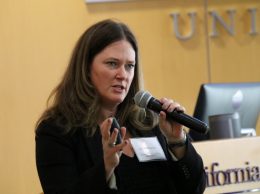Editorial: Prop. 30 promises may fall short on delivery
The promise of Proposition 30 was a simple one — pass a number of temporary tax increases and California will restore $6 billion of budget cuts to K-12 and higher education schools that otherwise would take effect in January.
But it turns out the post-election reality is far more complicated than the pre-election promise. The Ventura County Economic Development Association’s annual Business Outlook Conference, held the day after the election with business-education partnerships as the theme, underscores some of the fault lines that are emerging in the post-Prop. 30 world.
Public school superintendents and heads of public colleges and universities don’t see Prop. 30 as a panacea — to them, it is at best stop-gap that will keep things afloat for another few years. For K-12 administrators like Stan Mantooth of the Ventura County schools, thorny problems in updating school standards remain unaddressed.
For community colleges, CSU Channel Islands and Cal Poly, job No. 1 is tracking down December graduates and getting the mandated tuition rebates into their hands. Beyond that, Prop. 30 rolls back program cuts that would have kicked in on Jan. 1, but as CSUCI President Richard Rush stated, it does not repair cuts from the previous four years.
Businesses see a different story altogether. They see the educators’ victory as a mandate for schools to change in a way that more closely meets the needs of businesses, which, in surprising numbers, are facing a looming skills shortage. Airline pilots, truck drivers and technical folks of all kinds are in short supply, and businesses view Prop. 30’s $6 billion in new funding as a perfect opportunity to tweak curricula to meet this new demand.
Left on the sidelines of the discussion are private universities such as California Lutheran University, where President Chris Kimball is becoming increasingly aware that his institution’s fully-loaded costs are extremely competitive with public institutions, especially when legacy pension costs are factored into the equation.
Private colleges and universities have more flexibility in designing programs to meet the needs of business.
The bottom line on the discussion at the VCEDA conference and discussions at the annual San Luis Obispo County forecast on Nov. 9 is that the improving economy and the passage of Prop. 30 provide a unique opportunity for the Central Coast when it comes to workforce development and training.
Whether educational institutions, businesses and labor regulatory agencies can come together to design and execute effective programs remains to be seen.











